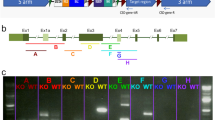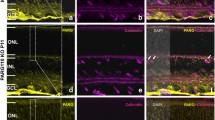Abstract
In the present work, Site-directed mutagenesis to insert the Glu50Lys amino acid substitution was achieved by PCR using plasmid pBluescript-OPTN. Mutated human OPTN(E50K) gene-driven mouse c-kit promoter was constructed and confirmed by endonuclease digestion and sequence analysis. Transgenic mice were generated via the microinjection method. PCR and DNA dot blot were used to screen the positive transgenic mice. RT-PCR analyzed the RNA level and location of mutated human OPTN(E50K) mRNA expression in transgenic mice. Western blot and immunohistochemistry were used to detect the level and location of mutated human OPTN(E50K) expression in transgenic mice. A transgenic mouse model with overexpression of mutated human OPTN(E50K) in retina was successfully established. The transgene was integrated and transmitted into the chromosome of transgenic mice. Mutated human OPTN(E50K) gene was controlled by c-kit promoter and expressed in the retina in mice. Mutated human OPTN(E50K) in transgenic mice was higher than that of wild type C57BL/6J mice. Our studies had provided a new transgenic model for investigating the molecular properties of mutated human OPTN(E50K).



Similar content being viewed by others
References
Thylefors B, Negrel AD, Pararajasegaram R, Dadzie KY (1995) Global data on blindness. Bull World Health Organ 73:115–121
Gordon MO, Beiser JA, Brandt JD, Heuer DK, Higginbotham EJ, Johnson CA, Keltner JL, Miller JP, Parrish RK, Wilson MR, Kass MA (2002) The ocular hypertension treatment study baseline factors that predict the onset of primary open-angle glaucoma. Arch Ophthalmol 120:714–720
Wiggs JL, Allingham RR, Hossain A, Kern J, Auguste J, DelBono EA, Broomer B, Graham FL, Hauser M, Pericak-Vance M, Haines JL (2000) Genome-wide scan for adult onset primary open angle glaucoma. Hum Mol Genet 9:1109–1117
Fan BJ, Wang DY, Lam DS, Pang CP (2006) Gene mapping for primary open angle glaucoma. Clin Biochem 39:249–258
Rezaie T, Child A, Hitchings R, Brice G, Miller L, Coca-Prados M, Heon E, Krupin T, Ritch R, Kreutzer D, Crick PP, Sarfarazi M (2002) Adult-onset primary open-angle glaucoma caused by mutations in optineurin. Science 295:1077–1079
Li Y, Kang J, Horwitz MS (1998) Interaction of an adenovirus E3 14.7-kilodalton protein with a novel tumor necrosis factor-inducible cellular protein containing leucine zipper domains. Mol Cell Biol 18:1601–1610
Hattula K, Peranen J (2000) FIP-2, a coiled-coil protein, links Huntington to Rab8 and modulates cellular morphogenesis. Curr Biol 10:1603–1606
Sahlender DA, Roberts RC, Arden SD, Spudich G, Taylor MJ, Luzio JP, Jones JK, Buss F (2005) Optineurin links myosin VI to the Golgi complex and is involved in Golgi organization and exocytosis. J Cell Biol 169:285–295
Schwamborn K, Weil R, Courtois G, Whiteside ST, Israel A (2000) Phorbolesters and cytokines regulate the expression of the NEMO-related protein, a molecule involved in a NF-κB-independent pathway. J Biol Chem 275:22780–22789
Anborgh PH, Godin C, Pampillo M, Dhami GK, Dale LB, Cregan SP, Truant R, Ferguson SS (2005) Inhibition of metabotropic glutamate receptor signaling by the huntingtin-binding protein optineurin. J Biol Chem 280:34840–34848
Zhu G, Wu CJ, Zhao Y, Ashwell JD (2007) Optineurin negatively regulates TNF-α induced NF-κB activation by competing with NEMO for ubiquitinated RIP. Curr Biol 17:1438–1443
Chalasani ML, Radha V, Gupta V, Agarwal N, Balasubramanian D, Swarup G (2007) A glaucoma-associated mutant of optineurin selectively induces death of retinal ganglion cells which is inhibited by antioxidants. Invest Ophthalmol Vis Sci 48:1607–1614
Park BC, Shen X, Samaraweera M, Yue BY (2006) Studies of optineurin, a glaucoma gene golgi fragmentation and cell death from overexpression of wild-type and mutant optineurin in two ocular cell types. Am J Pathol 169:1976–1989
Tsien JZ, Huerta PT, Tonegawa S (1996) The essential role of hippocampal CA1 NMDA receptor-dependent synaptic plasticity in spatial memory. Cell 87:1327–1338
Eriksson B, Bergqvist I, Eriksson M, Holmberg D (2000) Functional expression of Cre recombinase in sub-regions of mouse CNS and retina. FEBS Lett 479:106–110
Hogan B, Beddington R, Constantini F, Lacy E (1986) Manipulating the mouse embryo. Cold Spring Harbor, New York, pp 160–175
Pohl J, Laface D, Sands JF (1993) Transcription of retinoic acid receptor genes in transgenic mice increases CD8 T-cell subset. Mol Biol Rep 17:135–142
Kessler C (1994) Non-radioactive analysis of biomolecules. J Biotechnol 35:165–189
Mansfield ES, Worley JM, McKenzie SE, Surrey S, Rappaport E, Fortina P (1995) Nucleic acid detection using non-radioactive labelling methods. Mol Cell Probes 9:145–156
Kroeber M, Ohlmann A, Russell P, Tamm (2006) ER Transgenic studies on the role of optineurin in the mouse eye. Exp Eye Res 82:1075–1085
Hui Guo, Bian Ge, Xiao Cao, Lv Yan (2010) Down-regulation of Pkd2 by siRNAs suppresses cell–cell adhesion in the mouse melanoma cells. Mol Biol Rep 37:2387–2395
Yasuda H, Galli SJ, Geissler EN (1993) Cloning and functional analysis of the mouse c-kit promoter. Biochem Biophys Res Commun 191:893–901
Willoughby CE, Chan LL, Herd S, Billingsley G, Noordeh N, Levin AV, Buys Y, Trope G, Sarfarazi M, Heon E (2004) Defining the pathogenicity of optineurin in juvenile open-angle glaucoma. Invest Ophthalmol Vis Sci 45:3122–3130
Leung YF, Fan BJ, Lam DS, Lee WS, Tam PO, Chua JK, Tham CC, Lai JS, Fan DS, Pang CP (2003) Different optineurin mutation pattern in primary open-angle glaucoma. Invest Ophthalmol Vis Sci 44:3880–3884
Fuse N, Takahashi K, Akiyama H, Nakazawa T, Seimiya M, Kuwahara S, Tamai M (2004) Molecular genetic analysis of optineurin gene for primary open angle and normal tension glaucoma in the Japanese population. J Glaucoma 13:299–303
Alward WL, Kwon YH, Kawase K, Craig JE, Hayreh SS, Johnson AT, Khanna CL, Yamamoto T, Mackey DA, Roos BR, Affatigato LM, Sheffield VC, Stone EM (2003) Evaluation of optineurin sequence variation in 1048 patients with open angle glaucoma. Am J Ophthalmol 136:904–910
Funayama T, Ishikawa K, Ohtake Y, Tanino T, Kurosaka D, Kimura I, Suzuki K, Ideta H, Nakamoto K, Yasuda N, Fujimaki T, Murakami A, Asaoka R, Hotta Y, Tanihara H, Kanamoto T, Mishima H, Fukuchi T, Abe H, Iwata T, Shimada N, Kudoh J, Shimizu N, Mashima Y (2004) Variants in optineurin gene and their association with tumor necrosis factor-α polymorphisms in Japanese patients with glaucoma. Invest Ophthalmol Vis Sci 45:4359–4367
Mukhopadhyay A, Komatireddy S, Acharya M, Bhattacharjee A, Mandal AK, Thakur SK, Chandrasekhar G, Banerjee A, Thomas R, Chakrabarti S, Ray K (2005) Evaluation of optineurin as a candidate gene in Indian patients with primary open angle glaucoma. Mol Vision 11:792–797
Aung T, Rezaie T, Okada K, Viswanathan AC, Child AH, Brice G, Bhattacharya SS, Lehmann OJ, Sarfarazi M, Hitchings RA (2005) Clinical features and course of patients with glaucoma with the E50K mutation in the optineurin gene. Invest Ophthalmol Vis Sci 46:2816–2822
Rezaie MT (2003) Optineurin in primary open angle glaucoma. Ophthalmol Clin North Am 16:529–541
Acknowledgments
The authors are grateful to PHD. Hong Cai (Harbin veterinary research institute, CAAS) for his technical help. This project was funded by National Natural Science foundation of China (No. 81070730) and Key Program of Natural Science foundation of Heilongjiang province (ZD201015). China, patent 201110143751.5, 2011.
Author information
Authors and Affiliations
Corresponding author
Additional information
Qingfeng Meng and Zheng Xiao contributed equally to this work
Electronic supplementary material
Below is the link to the electronic supplementary material.
Rights and permissions
About this article
Cite this article
Meng, Q., Xiao, Z., Yuan, H. et al. Transgenic mice with overexpression of mutated human optineurin(E50K) in the retina. Mol Biol Rep 39, 1119–1124 (2012). https://doi.org/10.1007/s11033-011-0840-0
Received:
Accepted:
Published:
Issue Date:
DOI: https://doi.org/10.1007/s11033-011-0840-0




